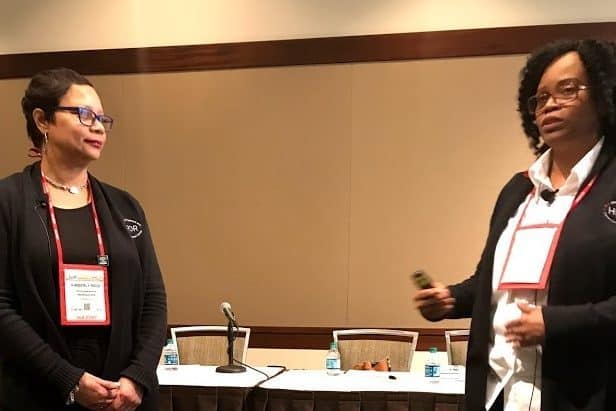
For many recent library school graduates, their first librarian job will be their first professional position. With that professionalism comes professional etiquette. With that in mind, Manager of Professional Development Beatrice Calvin and Program Officer Kimberly Redd of the American Library Association (ALA) Office for Human Resource Development and Recruitment presented “Professional Etiquette 101” at ALA’s 2019 Midwinter Meeting & Exhibits in Seattle.
“The whole point of professional etiquette is that you want to make the other person feel comfortable,” Calvin said. The pair discussed three aspects of etiquette geared toward making other people comfortable in a work environment: professional attire, professional communication, and professional dining skills.
Determining how to dress in a new work environment can be challenging. Dress codes are inherently vague, and even for those brave enough to ask directly, the answers aren’t always specific enough to be helpful. Calvin’s advice is to dress appropriately for the event or activity and be wrinkle-, link-, hole-, and stain-free. Beyond that, she advised, dress comfortably and for the job you want, not the job you have.
Regarding professional communication, Calvin noted, only 10 to 30% of communication is verbal, with 70 to 90% being nonverbal (think of tone of voice, body language, and facial expressions). “If you’re one of those people who shows what you’re feeling, you might want to practice” facial expressions in a mirror, Calvin said. “You want your face to show ‘I’m happy to be here in this conversation.’”
Calvin then went over tips for making connections. “Don’t jump straight into business talk,” she advised. Stay away from topics relating to politics, religion, or diet, and don’t dominate the conversation: “It’s a conversation. You talk for a little while, and you listen for a little while.”
Redd led the portion of the workshop on professional dining etiquette. Participants were given an assortment of cutlery and dishes and instructed to lay them on the table in the correct placement.
Anyone who’s attended a large formal dining event has experienced an awkward moment trying to figure out which glasses and cutlery are intended for your use. Redd gave a useful trick: Make a “b” and a “d” with your index finger and thumb on each hand. The side with a “b” is the side your bread plate is on, and the side with the “d” is the side your drinking glass is on. She also advised, “Remember, this is a business meeting, so take small bites because you’re going to be talking.” Participants agreed the session included useful tips on professional etiquette and felt better prepared for their next professional dining experience.


